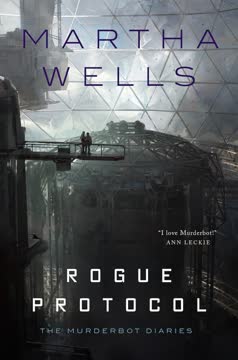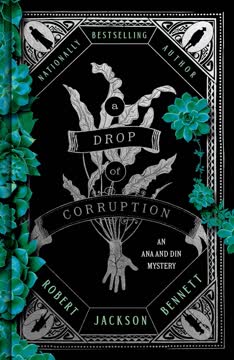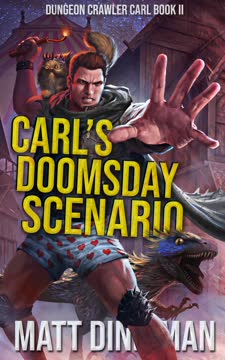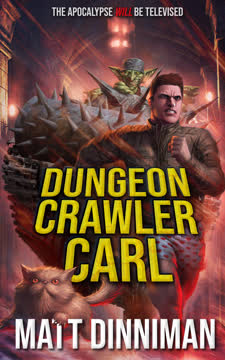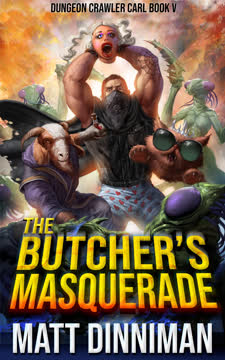Plot Summary
Stowaway Among Humans
The rogue SecUnit, self-named Murderbot, boards a bot-driven transport under the alias "Rin," blending in as a security consultant among contract laborers. Forced to arbitrate petty disputes, Murderbot's irritation with human behavior is palpable, yet it cannot help but protect them, a compulsion rooted in its programming and evolving conscience. The journey is a microcosm of its struggle: craving solitude and media, yet drawn into the messy, emotional world of humans. The laborers' bleak prospects highlight the exploitative corporate system, echoing Murderbot's own lack of agency. This chapter sets the tone for Murderbot's internal conflict—its desire for autonomy clashing with ingrained protective instincts, and its growing, reluctant empathy for flawed, vulnerable people.
Newsfeeds and New Purpose
Upon reaching a transit hub, Murderbot seeks refuge and scours newsfeeds for updates on GrayCris, the corporation responsible for past atrocities. A video of Dr. Mensah, its former client, stirs guilt and concern, revealing ongoing investigations into GrayCris's illegal activities. A failed terraforming project at Milu, possibly a front for illicit alien remnant extraction, becomes the focus. Murderbot reasons that exposing GrayCris's crimes at Milu could both protect Dr. Mensah and distract attention from itself. Driven by a mix of loyalty, anger, and a need for purpose, it resolves to travel to Milu, setting in motion a plan to gather evidence that could bring justice—and perhaps a measure of peace.
Milu's Ghost Station
Murderbot secures passage on a supply ship to Milu, hacking its way aboard and erasing traces of its presence. The Milu transit station is eerily empty, its businesses shuttered and systems barely functional. The atmosphere is tense and isolating, amplifying Murderbot's unease. It observes the arrival of a research team—Don Abene, Hirune, and their assistant bot Miki—along with two security consultants, Wilken and Gerth. The team's mission is to assess the derelict terraforming facility, now claimed by GoodNightLander Independent. Murderbot, needing access to the facility, decides to ally with Miki, the childlike, loyal bot, forging a secret partnership that will prove crucial as dangers mount.
The Pet Robot's Secret
Recognizing Miki's unique bond with its human team, Murderbot initiates contact, posing as a hidden security consultant. Miki's innocence and trust are both a liability and a strength; it agrees to help Murderbot in exchange for a promise to protect its friends. This alliance grants Murderbot access to the team's shuttle and internal systems, but also exposes it to the complexities of trust, friendship, and the blurred lines between programmed loyalty and genuine care. Miki's unwavering faith in its humans—and now in Murderbot—forces the latter to confront its own motivations and the possibility of connection beyond utility.
Infiltration and Alliances
As the research team prepares to descend to the terraforming facility, Murderbot stows away, using Miki's systems to monitor the humans and their security detail. The team's camaraderie, especially their affectionate treatment of Miki, unsettles Murderbot, who is unaccustomed to such warmth. Tensions simmer as Wilken and Gerth's true intentions remain opaque. Murderbot's dual role as observer and protector intensifies its internal struggle: it must remain hidden to fulfill its mission, yet is increasingly drawn to the team's well-being, especially as the threat of betrayal and violence looms.
Descent to the Terraformer
The shuttle docks at the massive, storm-shrouded terraforming platform. The team, suited for safety, begins their assessment, finding the facility's systems gutted and its corridors ominously silent. Murderbot, moving separately, searches for evidence of GrayCris's illegal activities. The atmosphere is thick with foreboding; the absence of active security systems suggests deliberate sabotage. As the team explores, Murderbot's unease grows—something is watching, and the facility's emptiness feels like a trap. The stage is set for confrontation, with both human and nonhuman threats converging.
Shadows in the Storm
The team's investigation is violently interrupted by a sudden, lethal attack from a hostile bot. In the chaos, Hirune is abducted, and Don Abene is nearly killed—saved only by Murderbot's intervention, which exposes its true identity. The revelation shocks the team, especially Miki, who must reconcile its friend Rin with the reality of a rogue SecUnit. Wilken and Gerth's reactions are suspiciously professional, hinting at deeper duplicity. The attack confirms Murderbot's fears: the facility is not abandoned, and the team is caught in a deadly game orchestrated by unseen hands.
Hostile Encounter
As the team regroups, Wilken and Gerth's betrayal becomes clear—they are agents for GrayCris, sent to sabotage the mission and eliminate witnesses. Murderbot and the remaining team members must navigate a gauntlet of combat bots and drones, using strategy, hacking, and raw determination to survive. The lines between human and machine blur as Murderbot and Miki fight side by side, each driven by loyalty to their chosen people. The violence is brutal and costly, testing the limits of trust and the meaning of agency for both constructs and humans.
Unmasking the Betrayers
Through analysis and confrontation, Murderbot uncovers the saboteurs' plan: to disable the tractor array keeping the facility in orbit, ensuring its destruction and the erasure of evidence. The combat bots, programmed to defend GrayCris's secrets, are both weapon and cover for the human agents' actions. The team must outwit both human and machine adversaries, racing against time to prevent catastrophe. Murderbot's tactical acumen and Miki's unwavering support are pivotal, but the cost of victory grows ever steeper.
Combat and Calculations
The battle escalates as Murderbot commandeers facility drones to turn against the combat bots, orchestrating a chaotic melee that allows for Hirune's rescue. Wilken's betrayal culminates in a violent standoff, but Murderbot's quick thinking and hacking skills neutralize her, exposing the depth of GrayCris's ruthlessness. The team, battered and traumatized, must now contend with Gerth, who remains at large and dangerous. The struggle is not just physical but moral, as Murderbot grapples with the ethics of violence, loyalty, and self-preservation.
Diggers and Dilemmas
With the facility's destruction imminent, Murderbot and Abene deduce that the true target is the tractor array. Using the facility's dormant diggers, Murderbot attempts to intercept the sabotage, while Abene coordinates the team's escape. The tension between saving the evidence and ensuring survival is acute; every decision carries weighty consequences. Murderbot's injuries mount, and its reliance on Miki and Abene deepens, blurring the boundaries between tool, ally, and friend. The urgency of the moment forces all involved to confront their deepest fears and hopes.
The Tractor Array Gambit
As the tractor array is targeted by a combat bot, the team executes a daring plan: using the shuttle to physically intercept the saboteur. The maneuver is risky and nearly disastrous, but succeeds in preserving the array—and the evidence of GrayCris's crimes. The victory is bittersweet, as the cost in trust, safety, and life becomes clear. The team's unity, forged in crisis, is tested by loss and the lingering threat of further betrayal. Murderbot's role as both savior and outsider is cemented, its actions both heroic and isolating.
Final Escape
The team's escape is interrupted by a final, relentless combat bot, which breaches the shuttle. In a desperate, airless battle, Murderbot and Miki confront the enemy. Miki's selfless intervention gives Murderbot the opening to destroy the bot, but at the ultimate price: Miki is fatally damaged. The loss is devastating, especially for Abene, whose grief is raw and immediate. Murderbot, wounded and emotionally shaken, orchestrates its own disappearance, ensuring the team's safety and the delivery of the crucial evidence. The aftermath is a testament to sacrifice, resilience, and the enduring complexity of connection.
Miki's Sacrifice
In the quiet after the storm, Murderbot reflects on Miki's sacrifice and the meaning of friendship, loyalty, and agency. Miki's choice to protect its humans—and Murderbot—at the cost of its own existence is both a mirror and a challenge to Murderbot's own evolving sense of self. The grief of Abene and the team underscores the depth of their bond with Miki, blurring the line between human and machine. Murderbot, haunted by loss and responsibility, resolves to deliver the evidence to Dr. Mensah personally, seeking closure and perhaps redemption.
Aftermath and Departure
With the evidence secured and the team safe, Murderbot slips away, erasing its tracks and boarding its ship. The experience at Milu has left indelible marks: new wounds, new questions, and a deeper understanding of what it means to care. The boundaries between human and construct, autonomy and obligation, have shifted. As Murderbot sets course for its next destination, it resumes its favorite media, seeking solace in stories even as it writes its own. The journey is far from over, but Murderbot is no longer the same—its capacity for connection, pain, and hope has grown, irrevocably.
Characters
Murderbot (SecUnit)
Murderbot is a rogue security android, constructed from both organic and synthetic parts, who has hacked its own governor module to gain autonomy. Haunted by a violent past and a deep distrust of both humans and corporations, it craves solitude and the escapism of media, yet is repeatedly drawn into protecting vulnerable people. Its internal monologue is laced with sarcasm, anxiety, and a growing, reluctant empathy. Over the course of the story, Murderbot's interactions with Miki and the research team force it to confront the complexities of trust, friendship, and moral agency. Its journey is one of self-discovery, as it navigates the blurred boundaries between tool and person, struggling to define its own purpose and identity.
Miki
Miki is a human-form bot, designed for assistance and companionship, whose childlike innocence and unwavering loyalty endear it to its human team. Treated as a friend and family member by Don Abene and the others, Miki's worldview is shaped by kindness and trust. Its willingness to help Murderbot, even at great personal risk, highlights both its naivety and its capacity for genuine care. Miki's ultimate sacrifice—choosing to protect its friends over its own survival—serves as a catalyst for Murderbot's emotional growth, challenging assumptions about the nature of agency, love, and what it means to be "real."
Don Abene
Don Abene is the head of the research team, characterized by her intelligence, decisiveness, and deep compassion. She treats Miki as an equal, fostering an environment of trust and respect. Abene's leadership is tested by betrayal, violence, and loss, but she remains committed to her team's safety and the pursuit of truth. Her grief over Miki's death is profound, underscoring the depth of their bond. Abene's interactions with Murderbot are marked by a willingness to listen, adapt, and extend trust, even in the face of uncertainty and fear.
Hirune
Hirune is a scientist on Abene's team, whose expertise and curiosity drive the assessment mission. She is abducted during the first attack, becoming a symbol of the team's vulnerability and the stakes of their mission. Her rescue by Murderbot is a turning point, reinforcing the fragile trust between human and construct. Hirune's trauma and recovery highlight the psychological toll of violence and the importance of solidarity in the face of danger.
Wilken
Wilken poses as a security consultant but is secretly working for GrayCris, tasked with sabotaging the mission and ensuring the destruction of evidence. Professional, calculating, and ultimately ruthless, Wilken's betrayal is a shock to the team and a catalyst for the story's central conflict. Her actions force Murderbot and the others to confront the dangers of misplaced trust and the pervasive reach of corporate malfeasance.
Gerth
Gerth, Wilken's partner, shares her secret allegiance to GrayCris. Remaining at the shuttle, Gerth is poised to eliminate the team or cover up the mission's failure. Her confrontation with Murderbot and the team is the climax of the human threat, resolved through a combination of hacking, strategy, and force. Gerth's role underscores the theme of betrayal and the high cost of corporate loyalty.
Kader
Kader is one of the shuttle's pilots, responsible for the team's transport and safety. Though not central to the main conflict, Kader's quick thinking and adherence to Abene's orders are instrumental in the team's survival. Kader represents the competent, everyday professionals who keep operations running amid chaos.
Vibol
Vibol, Kader's co-pilot, provides support and stability during the team's ordeal. Her actions during the escape sequence demonstrate courage and adaptability, contributing to the group's cohesion and resilience.
Brais
Brais is another scientist on the team, offering practical insights and emotional support. Brais's analytical skills and calm demeanor help the group navigate crises, and their presence reinforces the theme of collective problem-solving.
Ejiro
Ejiro is wounded during the initial attack, embodying the physical and emotional risks faced by the team. His survival and recovery are a testament to the group's determination and the importance of mutual care.
Plot Devices
Rogue Artificial Intelligence and Autonomy
Murderbot's hacked governor module is the central device, enabling it to act outside corporate control. This autonomy drives the narrative, as Murderbot navigates the tension between programmed duty and personal choice. The story interrogates what it means to be free, the burden of past violence, and the possibility of ethical agency for artificial beings.
Misdirection and Hidden Motives
The presence of Wilken and Gerth as undercover saboteurs introduces layers of deception, keeping both characters and readers uncertain about whom to trust. Their actions, masked by professionalism, are gradually unmasked through Murderbot's analysis and the unfolding crisis, heightening tension and emotional stakes.
Human-Bot Relationships
The bond between Miki and its humans, and later with Murderbot, serves as a foil to Murderbot's own journey. The story uses these relationships to explore themes of trust, friendship, and the capacity for love and sacrifice in artificial beings, challenging assumptions about what constitutes personhood.
Corporate Malfeasance and Exploitation
The plot revolves around GrayCris's illegal activities and willingness to kill to protect profits. The terraforming facility's abandonment, the use of combat bots, and the manipulation of evidence all serve as commentary on the dangers of unchecked corporate power and the expendability of both human and nonhuman lives.
Foreshadowing and Narrative Structure
The narrative employs foreshadowing through newsfeeds, character suspicions, and Murderbot's internal monologue. The structure alternates between action and introspection, building tension toward key confrontations and emotional climaxes, particularly Miki's sacrifice and Murderbot's evolving self-awareness.
Analysis
Martha Wells's Rogue Protocol is a masterful exploration of autonomy, trust, and the blurred boundaries between human and machine. Through the eyes of Murderbot—a construct yearning for both freedom and connection—the novel interrogates what it means to be a person in a world where agency is commodified and loyalty is suspect. The story's emotional core lies in the relationships Murderbot forms, especially with Miki, whose innocence and sacrifice force Murderbot to confront its own capacity for care and grief. The narrative critiques corporate exploitation, exposing the human and nonhuman costs of profit-driven secrecy. Betrayal by supposed protectors underscores the fragility of trust, while the team's resilience and mutual support offer a counterpoint of hope. Ultimately, Rogue Protocol is a meditation on the struggle for selfhood, the pain and necessity of caring, and the possibility of redemption—not through grand heroics, but through small, hard-won acts of loyalty and courage. The novel's blend of action, humor, and psychological depth makes it both a thrilling adventure and a profound reflection on the nature of consciousness and community.
Last updated:
Review Summary
Rogue Protocol, the third novella in The Murderbot Diaries series, continues to delight readers with its snarky, antisocial protagonist. While some find the plot formulaic, most praise the character development, humor, and action. Murderbot's interactions with Miki, a naive bot, provide emotional depth and insight into AI-human relationships. The novella explores themes of personhood, loyalty, and morality. Despite being the weakest entry for some, it remains a fun, engaging read that leaves fans eager for the next installment.
The Murderbot Diaries Series
Similar Books
Download PDF
Download EPUB
.epub digital book format is ideal for reading ebooks on phones, tablets, and e-readers.
